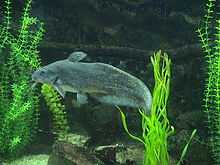Eel-tailed catfish
| Eel-tailed catfish | |
|---|---|
 | |
| Conservation status | |
| Not evaluated (IUCN 3.1) | |
| Scientific classification | |
| Kingdom: | Animalia |
| Phylum: | Chordata |
| Class: | Actinopterygii |
| Order: | Siluriformes |
| Family: | Plotosidae |
| Genus: | Tandanus |
| Species: | T. tandanus |
| Binomial name | |
| Tandanus tandanus (T. L. Mitchell, 1838) | |
| Synonyms | |
| |
The eel-tailed catfish, Tandanus tandanus, is a species of catfish (order Siluriformes) of the family Plotosidae.[1] This fish is also known as dewfish, freshwater catfish, jewfish, and tandan.[2]
This species is a freshwater fish native to the Murray-Darling river system of eastern Australia.[1] The scientific name for eel-tailed catfish comes from an aboriginal name for the fish - Tandan - which Major Thomas Livingston Mitchell recorded on his 1832 expedition.[3]
Description
Eel-tailed catfish commonly grow to about 50.0 centimetres (19.7 in) and weigh about 1.8 kilograms (4.0 lb).[4] Fish of this species may grow up to about 90.0 cm (35.4 in) and weigh up to 6.0 kg (13.2 lb).[3] Eel-tailed catfish may live up to about 8 years.[3]
Eel-tailed catfish have large head with thick and fleshy lips and tubular nostrils.[3] The skin is tough and smooth. Body coloration in adults vary from olive-green to brown, black or purplish on their backs and white on the underside.[3] A downturned mouth with fleshy lips surrounded by a number of barbels assist them with feeding. They are a solid, almost cylindrical, elongate fish, with the posterior half of their body tapering into a pointed eel-like tail. A continuous fin margin surrounds this tapering posterior half of the body. Their eyes are small.
Ecology

at Adelaide Zoo
The eel-tailed catfish inhabits slow moving streams, lakes and ponds with fringing vegetation. It swims close to the sand or gravel bottoms. This species is more abundant in lakes than in flowing water.[3] Though they are usually solitary, juveniles may form aggregations.[3] The eel-tailed catfish is found in most freshwater habitats of the Murray-Darling river system except for the upland, sub-alpine and alpine headwaters of southern tributaries. It is also present in speciated but undescribed forms in several east coast systems in northern New South Wales due to natural river capture events.[citation needed]
Juvenile eel-tailed catfish feed on zooplankton, and small insects, particularly chironomid larvae. Fish over about 100 mm also eat small fish while adults include shrimps, crayfish in the warmer months and midge larvae in winter. In addition, they eat mollusks and dragonfly, caddis and mayfly larvae.[5] The eel-tailed catfish is host for a number of intestinal parasites including cestodes and nematodes.[6]
Eel-tailed catfish spawn in spring and midsummer, when the water temperature increases to between 20–24°C (68–75°F.[3] The nest is built about one or two weeks before spawning.[3] They build large nests up to a metre in diameter with small stones and gravel, within which the eggs are laid.[7] One parent, sometimes both, guard the eggs until they hatch.[4]
Conservation
The Murray-Darling populations of eel-tailed catfish has declined significantly over recent decades.[4] Most populations in the southern half of the Murray-Darling river system are extinct or nearly so.[citation needed]
There are suggestions that introduced carp, with similar feeding habitats, directly compete with eel-tailed catfish, to the detriment of the catfish.[4] Severe siltation also probably severely impacts upon the species spawning by smothering the rocks and pebbles they use to build nests.[citation needed]
Fortunately, populations in several rivers and impoundments in the northern half of the Murray-Darling appear secure for now. Interestingly, the species does well in the upland reaches of these northern Murray-Darling rivers; this is in contrast to its absence from the upland reaches of southern Murray-Darling rivers, where water temperatures are cooler.[citation needed]
References
- ↑ 1.0 1.1 Ferraris, Carl J., Jr. (2007). "Checklist of catfishes, recent and fossil (Osteichthyes: Siluriformes), and catalogue of siluriform primary types" (PDF). Zootaxa 1418: 1–628. Retrieved 2009-06-24.
- ↑ "Freshwater Catfish". Fish.gov.au. Retrieved 2007-08-01.
- ↑ 3.0 3.1 3.2 3.3 3.4 3.5 3.6 3.7 3.8 Froese, Rainer and Pauly, Daniel, eds. (2012). "Tandanus tandanus" in FishBase. February 2012 version.
- ↑ 4.0 4.1 4.2 4.3 "Eel Tailed Catfish". Native Fish Australia. Retrieved 2007-08-01.
- ↑ McDowall, Robert (1996). Freshwater Fishes of South-eastern Australia (rev ed.). Sydney: Reed Books. p. 111. ISBN 0-7301-0462-1.
- ↑ Couch, A.J.; 1983. "Some Parasites of the Freshwater Catfish Tandanus tandanus (Mitchell)" (PDF). Retrieved 2009-02-21.
- ↑ Allen, G.R.; et al. (2002). Freshwater Fishes of Australia. Western Australian Museum. pp. 75,88. ISBN 0-7307-5486-3.